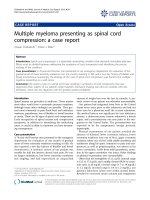Báo cáo y học: " Servelle-Martorell syndrome with extensive upper limb involvement: a case repor" pptx
Bạn đang xem bản rút gọn của tài liệu. Xem và tải ngay bản đầy đủ của tài liệu tại đây (252.95 KB, 4 trang )
BioMed Central
Page 1 of 4
(page number not for citation purposes)
Journal of Medical Case Reports
Open Access
Case report
Servelle-Martorell syndrome with extensive upper limb
involvement: a case report
Raju Karuppal*, Rajendran V Raman, Brijesh P Valsalan, TS Gopakumar,
Chathoth Meethal Kumaran and Chembu Kara Vasu
Address: Medical College, Calicut, 673008 Kerala, India
Email: Raju Karuppal* - ; Rajendran V Raman - ;
Brijesh P Valsalan - ; TS Gopakumar - ; Chathoth Meethal Kumaran - ;
Chembu Kara Vasu -
* Corresponding author
Abstract
Introduction: Angio-osteohypotrophic syndrome is also known as Servelle-Martorell
angiodysplasia. It is characterized by venous or, rarely, arterial malformations, which may result in
limb hypertrophy and bony hypoplasia. Extensive involvement of the upper limb is a rare feature of
Servelle-Martorell syndrome. Cases with minimal upper limb involvement have been described in
the literature.
Case presentation: A young man presented with multiple separate swollen areas over the right
upper limb and functional difficulty since birth. The arm muscles and muscles of the limb girdle were
atrophic. The forearm and hand bones were hypoplastic and tender.
Conclusion: We report a case of Servelle-Martorell syndrome with extensive involvement of the
entire upper limb and periscapular region. Servelle-Martorell syndrome is highlighted as one of the
causes of angiodysplastic limb hypertrophy.
Introduction
Servelle-Martorell syndrome is characterized by limb
hypertrophy owing to venous and rarely, arterial, malfor-
mations with skeletal abnormalities (hypoplasia) [1].
Similar conditions such as Klippel-Trenaunay, Parkes-
Weber and Blue rubber bleb nevus syndromes can present
with limb and bone hypertrophy. MRI is the best imaging
method for diagnosis [1]. Adequate radiological investiga-
tions with corroborative clinical findings are crucial to
establish correct diagnosis. The prognosis of this disorder
is uncertain. Therapy is predominantly conservative. In
the presence of aneurysmal complications or severe
shunting, surgery may be indicated. Servelle-Martorell
syndrome has been reported rarely in the literature.
Case presentation
A 21-year-old man presented with an enlarged right upper
limb and functional difficulty. The arm had been larger
than the opposite limb since birth and was occasionally
painful and swollen. The pain and swelling were worse
when the limb was lowered. Close examination showed
multiple separate swollen areas over the whole of the arm
and shoulder girdle (Figure 1). These differed in size; they
were soft and compressible, and significantly decreased in
size with elevation. The right arm was shorter than the left
Published: 3 May 2008
Journal of Medical Case Reports 2008, 2:142 doi:10.1186/1752-1947-2-142
Received: 4 September 2007
Accepted: 3 May 2008
This article is available from: />© 2008 Karuppal et al; licensee BioMed Central Ltd.
This is an Open Access article distributed under the terms of the Creative Commons Attribution License ( />),
which permits unrestricted use, distribution, and reproduction in any medium, provided the original work is properly cited.
Journal of Medical Case Reports 2008, 2:142 />Page 2 of 4
(page number not for citation purposes)
and this reduction in length was due to overall shortening
rather than localized shortening within a particular sec-
tion of the limb. The arm muscles and muscles of the limb
girdle were atrophic.
The palm had a bluish discoloration. Other parts of the
body showed no abnormalities. The peripheral pulses
were palpable with equal volume on both sides. The fore-
arm and hand bones were hypoplastic and tender. There
was no sensory deficit. The muscle strength of the right
upper limb was Medical Research Council (MRC) grade
III to IV. No bruits or thrills were found. No temperature
difference was observed. The elbow flexed fully but had
restriction of extension when held in a position of 80
degrees of fixed flexion. The cardiovascular system was
normal.
Investigation revealed a normal blood picture. Radio-
graphs showed multiple soft tissue swellings and hypotro-
phy of the bones of right upper limb. There were multiple
well-defined radio-opaque lesions consistent with phle-
boliths in the affected upper limb and periscapular region
(Figure 2).
Musculoskeletal ultrasound showed multiple dilated tor-
tuous anechoic lesions involving the upper limb and per-
iscapular region. Echogenic lesions with shadowing
suggestive of phleboliths were seen inside the anechoic
lesions. The forearm muscles were thinned and replaced
by these anechoic lesions.
Color Doppler study showed no flow within the lesion
but, while performing a Valsalva maneuver, there was
sluggish flow within the lesion suggestive of dilated tor-
turous venous channels involving the superficial venous
system. The proximal part of the deep venous system
appeared normal but the distal part was not visualized.
The arterial system appeared normal.
An MRI study showed multiple dilated veins in the super-
ficial aspect of the right upper limb (Figure 3). The mus-
cles of the limb were replaced by an abnormal signal. The
triceps, biceps and deltoid were partially involved. No
intra-osseous venous malformation was seen. The arteries
were normal.
We managed this case nonoperatively by external com-
pression with graduated compression stockings. Com-
pression therapy helped to diminish the symptoms of
venous insufficiency. The patient does not have any com-
plications such as venous thrombosis, consumption coag-
ulopathy, recurrent cellulitis or recurrent bleeding.
Discussion
Servelle-Martorell syndrome is also known as phlebectatic
osteohypoplastic angiodysplasia [2]. The ectasia and
aneurysmal dilatation of the superficial veins may result
in a monstrous deformity of the extremity. In the deep
venous system, an abnormal vein location, partial or com-
plete lack of valves, and/or venous hypoplasia or aplasia
has been observed. Intra-osseous vascular malformations
may lead to hypoplasia of the bone with the destruction
of spongiosa and cortical bone, resulting in shortening
X-ray showing multiple soft-tissue swellings, hypotrophy of the bone, and multiple well-defined, radio-opaque lesions consistent with phlebolithsFigure 2
X-ray showing multiple soft-tissue swellings, hypotrophy of
the bone, and multiple well-defined, radio-opaque lesions
consistent with phleboliths.
Multiple soft tissue swelling involving the entire upper limb, axilla and periscapular regionFigure 1
Multiple soft tissue swelling involving the entire upper limb,
axilla and periscapular region.
Journal of Medical Case Reports 2008, 2:142 />Page 3 of 4
(page number not for citation purposes)
and hypoplasia of the limb [2]. Intra-osseous vascular
ectasias can result in joint destruction. Radiographs can
demonstrate multiple soft-tissue swellings, hypoplasia of
the bones and multiple phleboliths in the venous ectasias.
The prognosis of this disorder is uncertain.
Venous vascular malformations span a wide spectrum,
varying from isolated cutaneous ectasias to voluminous
lesions involving manifold tissues and organs. They are
soft and compressible, and show no alteration in skin
temperature, thrill or bruits. These are frequently and
incorrectly termed 'cavernous hemangiomas'. Pure
venous malformations usually exhibit blue coloration of
the skin or in the overlying mucosa, while the combined
venous malformations and capillaries exhibit a hue that
ranges from dark-red to violet [1,3]. The venous malfor-
mations are hemodynamically inactive, with a low flow.
The condition deteriorates with pregnancy or trauma
[4,5]. Absence of overgrowth of the limbs distinguishes it
from combined vascular malformations, such as Klippel-
Trenaunay syndrome. There may be demineralization,
hypoplasia or lytic changes in the underlying bones in up
to 71% of cases [4].
Venous thrombosis is a regular complication, and the
thrombi may be palpated at the point of pain, but in this
case there were no complications related to the venous
thrombosis. Another possible complication is the devel-
opment of consumption coagulopathy due to stasis in the
ectatic vascular canals [6]. The possibility of consumption
coagulopathy must be investigated prior to undertaking
any invasive procedures [3-5].
In the majority of cases, diagnosis is made from the clini-
cal features. A simple radiograph may reveal phleboliths
and bone hypoplasia at the age of 2 or 3 years. Magnetic
resonance is the best examination to delimit vascular mal-
formation [1].
Based on observations of 47 cases of angiodysplasia of
types Parkes-Weber, Klippel-Trenaunay and Servelle-Mar-
torell, Langer et al. [7] demonstrated that differentiation
of these three syndromes is possible by taking standard X-
rays of the extremities (both sides), which are examined
under direct magnification (0.1 – 01 mm). The Weber
syndrome should be suspected if bone lengthening is seen
in association with loss of substances from the skeleton.
In the Klippel-Trenaunay syndrome, the bony lesions do
not accompany lengthening. In the Servelle-Martorell syn-
drome, bony lesions appear together with limb hypertro-
phy [1,4].
Arteriography and phlebography are required in Servelle-
Martorell angiodysplasia to demonstrate the ectatic
regions of the involved vessels [8], whereas only phlebog-
raphy may be needed in Klippel-Trenaunay syndrome.
The majority of the reported cases had a limited area of
involvement [2]. The extensive involvement of the entire
upper limb and the periscapular region made this case
rare.
Nonoperative management is adequate for most patients
with Servelle-Martorell syndrome. This includes external
compression with graduated compression stockings and
garments. Compression therapy can be helpful in protect-
ing the limb, even from minimal trauma that can cause
bleeding of the large superficial malformations. It has no
effect, however, on the ultimate size of the limb. Patients
Magnetic resonance imaging scan multiple dilated veins in the superficial aspect of the right upper limb with bone hypopla-siaFigure 3
Magnetic resonance imaging scan multiple dilated veins in the
superficial aspect of the right upper limb with bone hypopla-
sia.
Journal of Medical Case Reports 2008, 2:142 />Page 4 of 4
(page number not for citation purposes)
with significant edema of the lower limbs can be treated
with diuretics.
Sclerotherapy with local injection of 95% alcohol or 1%
sodium tetradecyl sulphur may be used for small lesions.
Surgical resection may then be performed following suc-
cessful obliteration. The embolization of arteries sustain-
ing the malformation is contraindicated since it may
provoke tissue necrosis.
Patients with recurrent attacks of cellulitis may benefit
from prophylactic antibiotic therapy. Anticoagulants are
indicated after deep vein thrombosis or pulmonary embo-
lus. Patients with recurrent superficial thrombophlebitis
frequently require daily administration of aspirin or ibu-
profen; however, this may promote problems with bleed-
ing.
Surgery should not be done to improve cosmesis at the
expense of function. Aneurysmal complications or severe
shunting may be an indication of the requirement for sur-
gery. Surgical excision is the definitive therapy, often ren-
dered impossible, however, by anatomic, esthetic and
functional limitations [1,9]. Amputation of a grossly
hypertrophied, poorly functioning digit may be necessary
but a more proximal foot, hand or limb amputation is
rarely required. Symptomatic varicosities or localized
venous malformations can be removed in selected
patients with good results provided that there is a func-
tioning deep vein system. It should be recognized that
complete excision of extensive malformations with
debulking procedures is seldom possible.
Debulking procedures can damage venous and lymphatic
structures and lead to increased edema of the affected part,
scar formation, recurrence, chronic wound infection, and
chronic weeping lymphoedema [10].
Conclusion
Servelle-Martorell syndrome is a rare condition, the diag-
nosis of which can be confused with Klippel-Trenaunay,
Parkes-Weber and blue rubber bleb nevus syndromes.
Venous malformations are present in all these conditions;
bony hypoplasia is characteristic of Servelle-Martorell syn-
drome. Although it is rare, extensive limb involvement
may be seen in Servelle-Martorell syndrome. MRI is useful
in assessing the extent of venous malformations. Conserv-
ative treatment is recommended in most cases. Sclerother-
apy, with or without surgery, is recommended in cases of
functional impairment, even if recurrences are frequent.
Competing interests
The authors declare that they have no competing interests.
Authors' contributions
RK contributed to conception and design, acquisition of
data, and analysis and interpretation of data. RVR contrib-
uted to analysis and interpretation of the investigations.
BPV contributed to the acquisition of data and data anal-
ysis. TSG contributed to conception and design, and
revised the manuscript critically for important intellectual
content. CMK contributed by revising and giving final
approval of the version to be published. CKV contributed
by revising the manuscript critically for important intel-
lectual content. All authors read and approved the final
manuscript.
Consent
Written informed consent was obtained from the patient
for publication of this case report and any accompanying
images. A copy of the written consent is available for
review by the Editor-in-Chief of this journal.
Acknowledgements
The authors deeply acknowledge Dr Anwar Marthya, Senior Lecturer in
Orthopedics, for his substantial contribution to the design, drafting and
critical revision of the manuscript.
References
1. Enjolras O, Mulliken JB: Vascular malformations. In Textbook of
Pediatric Dermatology Oxford: Blackwell Science; 2000:975-996.
2. Weiss T, Madler U, Oberwittler H, Kahle B, Weiss C, Kubler W:
Peripheral vascular malformation (Servelle-Martorell). Circu-
lation 2000, 101(7):82-83.
3. Fishman SJ, Mulliken JB: Hemangiomas and vascular malforma-
tions of infancy and childhood. Pediatr Clin North Am 1993,
40:1177-1200.
4. Enjolras O, Mulliken JB: Vascular tumours and vascular malfor-
mations (new issues). Adv Dermatol 1998, 13:375-423.
5. Burns AJ, Kaplan LC, Mulliken JB: Is there an association between
hemangiomas and syndromes with dysmorphic features?
Pediatrics 1991, 88:1257-1267.
6. Wong L, Rogers M, Lammi A: Severe cyclical thrombocytopenia
in a patient with a large lymphatic-venous malformation: a
potential association? Australas J Dermatol 2001, 42:38-42.
7. Langer M, Langer R, Friedrich JM: Congenital angiodysplasia of
types F.P. Weber, Klippel-Trenaunay and Servelle-Mar-
torell. J Mal Vasc 1982, 7:317-324.
8. Langer M, Langer R: Radiologic aspects of the congenital arte-
riovenous malformations, Klippel-Trenaunay type, and Ser-
velle-Martorell type. Rofo 1982, 136:577-582.
9. Angel C, Yngve D, Murillo C, Hendrick E, Adegboyega P, Swischuk L:
Surgical treatment of vascular malformations of the extrem-
ities in children and adolescents. Pediatr Surg Int 2002,
18:213-217.
10. Cliff SH, Mortimer OS: Disorders of lymphatics. In Textbook of
Pediatric Dermatology Oxford: Blackwell Science; 2000:1017-1034.









